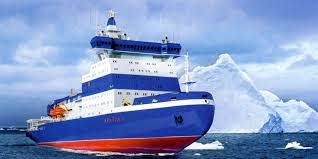WNN
Oil & Gas Publishers Note: These large investments will help Russia maintain the cashflow from fossil fuels which make a substantial portion of their GDP.
Russian President Vladimir Putin has signed an executive order, On the Strategy for Developing the Russian Arctic Zone and Ensuring National Security until 2035, which foresees the construction of at least five new nuclear-powered icebreakers of the Project 22220 series, and three of the Project 10510 series. The vessels are needed to ensure year-round navigation along the Northern Sea Route.
Project 10510, also known through the Russian type size series designations LK-110Ya and LK-120Ya or the project name Leader, will supersede Project 22220 icebreakers as the largest and most powerful in the world.
The executive order, which was published on 26 October, also states that Russia will have 16 rescue and tug-rescue vessels of various capacities, three hydrographic and two pilot ships.
 With a length of 173.3 metres, a width of 34m and a displacement of 33.5 thousand tonnes, the Project 22220 vessels are currently the world’s biggest nuclear-powered icebreakers. One fuel load for a RITM-200 unit is equivalent to 540,000 tonnes of Arctic diesel fuel, it said, with fuel reloads required once every seven years.
With a length of 173.3 metres, a width of 34m and a displacement of 33.5 thousand tonnes, the Project 22220 vessels are currently the world’s biggest nuclear-powered icebreakers. One fuel load for a RITM-200 unit is equivalent to 540,000 tonnes of Arctic diesel fuel, it said, with fuel reloads required once every seven years.
The Leader vessels have a capacity of 120 MWe, a speed of 22 knots (in clear water), a displacement of almost 70,000 tonnes, a length of 209m, a width of 47.7m, and a maximum icebreaking potential of 4m. Each carries two reactors of the RITM-400 type; a steam turbine unit with four 37-MW turbine generators, and an electric propulsion system with four propeller motors of 30 MW each.
These icebreakers will guide vessels from hydrocarbon deposits in the Yamal and Gydan peninsulas and from the shelf of the Kara Sea to markets in the Asia-Pacific region.
The Project 22220 vessels will join the LK-60 icebreakers Arktika, Sibir and Ural, which are dual-draught (8.55 or 10.5m) wide-beam (34m) ships of 25,450 dwt or 33,540 dwt with ballast, able to handle 3m of ice. They each have two RITM-200 reactors of 175 MWt each, delivering 60 MWe at the propellers via twin turbine-generators and three motors. Arktika enters operation this year, Sibir in 2021 and Ural in 2022.

